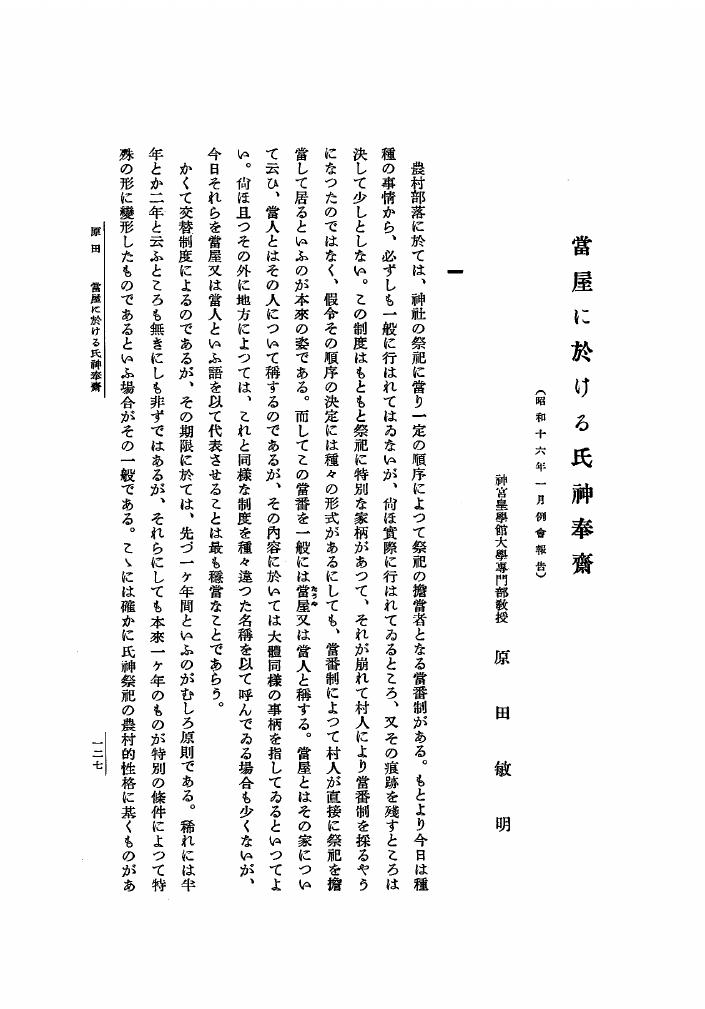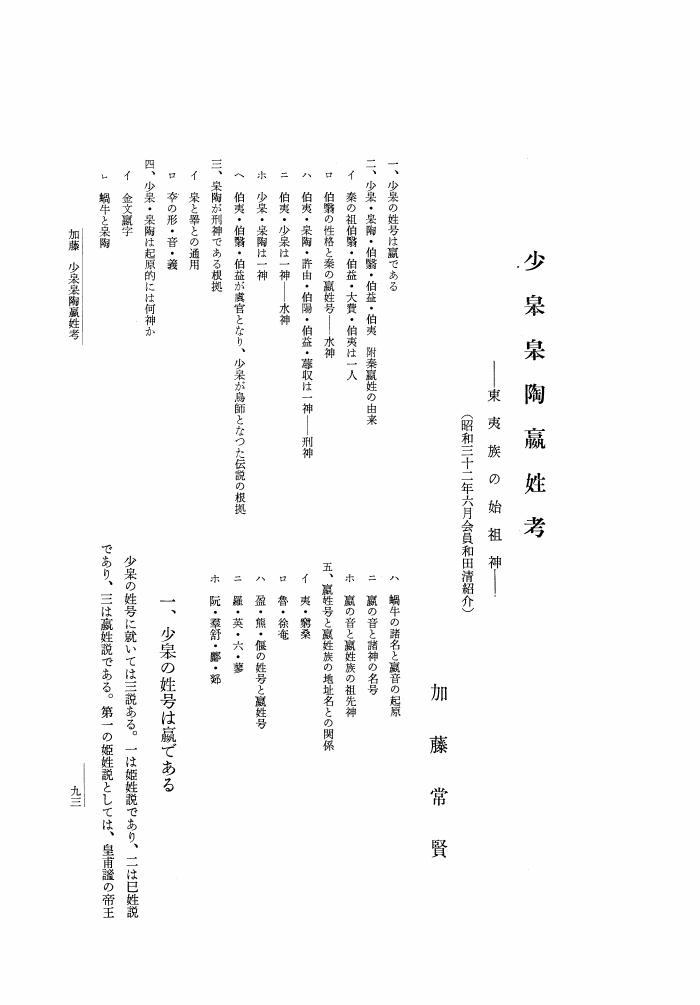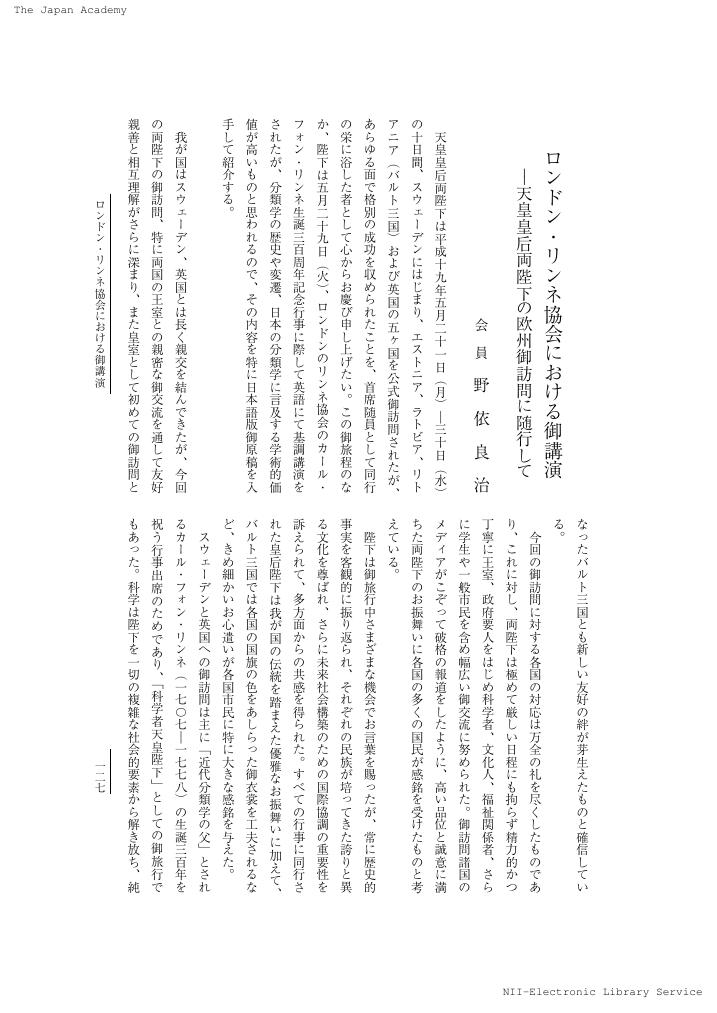1 0 0 0 OA 御觸書集成に就て (昭和十七年二月十二日報告)
- 著者
- 石井 良助
- 出版者
- 日本学士院
- 雑誌
- 帝國學士院紀事 (ISSN:03879984)
- 巻号頁・発行日
- vol.1, no.3, pp.457-484, 1942 (Released:2007-05-30)
- 著者
- 姉崎 正治
- 出版者
- 日本学士院
- 雑誌
- 帝國學士院紀事 (ISSN:03879984)
- 巻号頁・発行日
- vol.1, no.3, pp.485-506, 1942 (Released:2007-05-30)
- 著者
- 姉崎 正治
- 出版者
- 日本学士院
- 雑誌
- 帝國學士院紀事 (ISSN:03879984)
- 巻号頁・発行日
- vol.1, no.1, pp.1-27, 1942 (Released:2007-05-30)
1 0 0 0 OA 方丈記と支那文學との關係 主として白樂天詩文との關係に就いて (昭和十七年一月例會報告)
- 著者
- 金子 彦二郎
- 出版者
- 日本学士院
- 雑誌
- 帝國學士院紀事 (ISSN:03879984)
- 巻号頁・発行日
- vol.1, no.1, pp.29-93, 1942 (Released:2007-05-30)
1 0 0 0 OA 藤樹學者淵岡山と其學派、事蹟の研究 (昭和十五年一月例會報告)
- 著者
- 柴田 甚五郎
- 出版者
- 日本学士院
- 雑誌
- 帝國學士院紀事 (ISSN:03879984)
- 巻号頁・発行日
- vol.1, no.1, pp.95-125, 1942 (Released:2007-05-30)
1 0 0 0 OA 當屋に於ける氏神奉齋 (昭和十六年一月例會報告)
- 著者
- 原田 敏明
- 出版者
- 日本学士院
- 雑誌
- 帝國學士院紀事 (ISSN:03879984)
- 巻号頁・発行日
- vol.1, no.1, pp.127-145, 1942 (Released:2007-05-30)
- 著者
- 關 寛之
- 出版者
- 日本学士院
- 雑誌
- 帝國學士院紀事 (ISSN:03879984)
- 巻号頁・発行日
- vol.1, no.1, pp.147-190, 1942 (Released:2007-05-30)
1 0 0 0 OA 晉代の遼東 (昭和十七年二月十二日報告)
- 著者
- 池内 宏
- 出版者
- 日本学士院
- 雑誌
- 帝國學士院紀事 (ISSN:03879984)
- 巻号頁・発行日
- vol.1, no.1, pp.191-213, 1942 (Released:2007-05-30)
- 著者
- 姉崎 正治
- 出版者
- 日本学士院
- 雑誌
- 帝國學士院紀事 (ISSN:03879984)
- 巻号頁・発行日
- vol.1, no.2, pp.225-264, 1942 (Released:2007-05-30)
1 0 0 0 OA 上代文学における色彩 (昭和四十九年三月十二日 会員 久松潜一 紹介)
- 著者
- 伊原 昭
- 出版者
- 日本学士院
- 雑誌
- 日本學士院紀要 (ISSN:03880036)
- 巻号頁・発行日
- vol.32, no.2, pp.57-98, 1974 (Released:2007-05-30)
1 0 0 0 OA 少皋皋陶〓姓考 東夷族の始祖神 (昭和三十二年六月会員和田清紹介)
- 著者
- 加藤 常賢
- 出版者
- 日本学士院
- 雑誌
- 日本學士院紀要 (ISSN:03880036)
- 巻号頁・発行日
- vol.15, no.2, pp.93-134, 1957 (Released:2007-05-30)
1 0 0 0 OA 英国産業革命論の現在
- 著者
- 斎藤 修
- 出版者
- 日本学士院
- 雑誌
- 日本學士院紀要 (ISSN:03880036)
- 巻号頁・発行日
- vol.76, no.2, pp.203-234, 2022 (Released:2022-02-15)
- 参考文献数
- 57
The historical interpretation of the British industrial revolution has undergone a significant change since the 1960s. The publication of British Economic Growth, 1688-1959 by P. Deane and W. A. Cole in 1962 marked an epoch by applying national accounting methods to eighteenth- and nineteenth-century historical data. Their stage-specific estimates of real gross domestic product (GDP) growth were thought to reflect the acceleration process of industrial and GDP growth in the c.1760-1830 period, during which a series of innovations are said to have revolutionised the scene of manufacturing. However, this interpretation was radically revised by Nick Crafts' 1985 book, British Economic Growth during the Industrial Revolution. With his estimates of slower rates of GDP growth and arguments derived from growth accounting analysis, it is suggested that the contribution of new technologies (such as steam engine) to output growth was surprisingly low, taking more time in harvesting the fruit of a general-purpose technology (GPT) than we tended to assume. The thesis of slow growth was reconfirmed by a 1992 joint-paper by Crafts and Knick Harley and the growth accounting scenario by Crafts' own 2018 book. (View PDF for the rest of the abstract.)
- 著者
- 小山 敦子
- 出版者
- 日本学士院
- 雑誌
- 日本學士院紀要 (ISSN:03880036)
- 巻号頁・発行日
- vol.19, no.2, pp.75-82, 1961 (Released:2007-05-30)
1 0 0 0 OA 定家歌論書考 (二) (昭和四十年二月十二日 提出)
- 著者
- 久松 潜一
- 出版者
- 日本学士院
- 雑誌
- 日本學士院紀要 (ISSN:03880036)
- 巻号頁・発行日
- vol.23, no.1, pp.19-30, 1965 (Released:2007-05-30)
1 0 0 0 OA 芭蕉と寓言説(一) (昭和三十五年五月十九日 会員 久松潜一紹介)
- 著者
- 小西 甚一
- 出版者
- 日本学士院
- 雑誌
- 日本學士院紀要 (ISSN:03880036)
- 巻号頁・発行日
- vol.18, no.2, pp.97-118, 1960 (Released:2007-05-30)
1 0 0 0 OA 中世末期における三条西家の経済的基盤とその崩壊
1 0 0 0 OA 意識を創発するワーキングメモリ
- 著者
- 苧阪 直行
- 出版者
- 日本学士院
- 雑誌
- 日本學士院紀要 (ISSN:03880036)
- 巻号頁・発行日
- vol.70, no.3, pp.135, 2016 (Released:2016-12-28)
- 参考文献数
- 47
- 被引用文献数
- 1
Consciousness plays an essential role in high-level cognition, which includes a long list of tasks such as perception, language comprehension, self-recognition, representation of other's mind, mental operations, complex reasoning and problem solving. Despite its importance, the neural basis of consciousness have not yet been revealed. Functional magnetic resonance imaging (fMRI) is an established technique for the study of neural correlates of consciousness (NCC) that involve high-level cognition by measuring cardiovascular responses. These works have indicated that the conscious mind emerges from the interaction of multiple neural networks. Among these networks, the working (executive) memory (WM) network coupled with the default mode network and dorsal attentional-network have been recently recognized to play a major role. We show evidences from cognitive social neuroscience experiments that indicate neural mechanisms supporting WM play a critical role in generating consciousness through executive functions such as updating, shifting and inhibiting incoming information. These executive works function in the dorsolateral and ventrolateral prefrontal cortex (PFC) and anterior cingulate cortex, with coordination across these and other brain areas being related to task dependent processes. WM's capacity limitation also plays a critical for active consciousness. Theoretical modeling of consciousness using graph theory, with which we can quantify large-scale networks of the brain, supports our WM-based consciousness. We propose a three-layered model of consciousness consisting of vigilance-, awareness-, and recursive-consciousness, which correspond to biological-, sensory-motor-, and self-consciousness, respectively. Among these layers, self-consciousness is likely critical for social interaction, which involves working together with other minds. Consistently, modular brain areas that bind multiple minds have been found in the medial PFC using fMRI. By introducing a false believe task, we confirmed high-level intentionality and meta-representation could also be involved in WM's executive function working on the dorsolateral PFC, which makes inference of another's mind possible.
1 0 0 0 Q式血液型とその遺伝 (昭和二十四年二月十二日報告)
- 出版者
- 日本学士院
- 雑誌
- 日本學士院紀要 (ISSN:03880036)
- 巻号頁・発行日
- vol.7, no.2, pp.87-94, 1949
1 0 0 0 OA 天皇陛下基調御講演「リンネと日本の分類学」:--生誕三百年を記念して--
- 著者
- 天皇陛下
- 出版者
- 日本学士院
- 雑誌
- 日本學士院紀要 (ISSN:03880036)
- 巻号頁・発行日
- vol.62, no.2, pp.127-140, 2007 (Released:2017-04-05)
1 0 0 0 OA 日本資本主義の多重危機
- 著者
- 伊藤 誠
- 出版者
- 日本学士院
- 雑誌
- 日本學士院紀要 (ISSN:03880036)
- 巻号頁・発行日
- vol.76, no.1, pp.79-99, 2021 (Released:2021-11-20)
Japanese capitalism has formed a vicious circle among multiple socio-economic crises under neoliberalism. This paper reexamines the historical origin of these crises, their structural relations, and identify their core, fundamental issues. It will be shown also how three different types of natural disasters also deepen socio-economic crises, thereby endangering the metabolic reproduction of human lives and nature. How can we overcome such an age of deep crises? More than ever, it is indispensable to reconsider the historical significance and task of transforming neoliberal capitalism in the world and in Japan. (1) Six multiple crises in a structural, vicious circle The inflationary crisis of 1973-75 initiated a long downturn of Japanese capitalism. In addition to the excessive supply of currencies and credit in the process of transition from the Bretton Woods international monetary system to the floating exchange rates system, over-accumulation of industrial capital in relation to the limitation of flexible supply of both labor power within major capitalist economies and primary products such as crude oil in the world market inevitably caused sharp rises in wages and prices of primary products and squeezed profit rates as a fundamental factor behind the crisis. In this regard the inflationary crisis revealed anew the basic contradiction of capitalist economy in the commodification of labor power, together with the instability of credit mechanisms. (View PDF for the rest of the abstract.)















